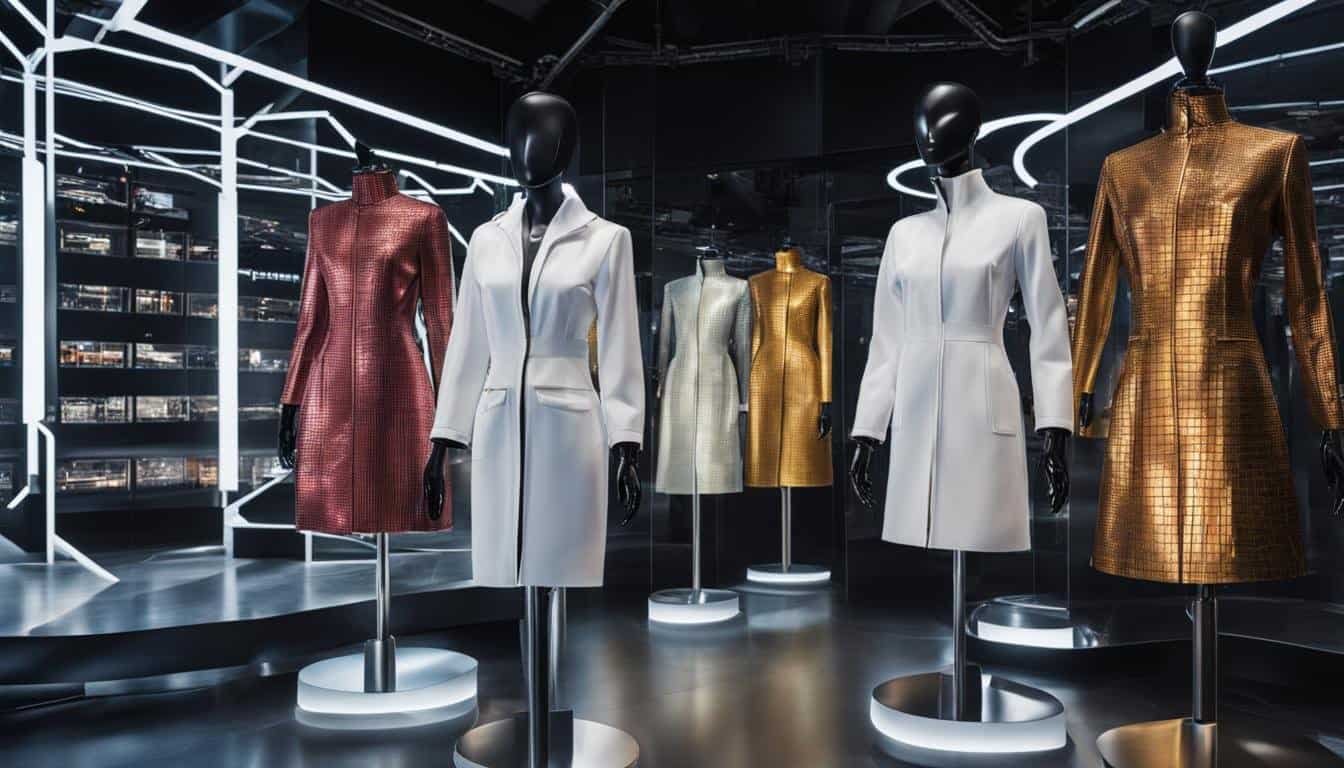AI in Fashion: Tailoring the Future
The fashion industry is undergoing a transformation with the rapid advancement of technology, particularly artificial intelligence (AI). AI is revolutionizing various aspects of the fashion industry, from design and production to retail and marketing. In this article, we will explore how AI is shaping the future of fashion and personalizing the industry for consumers.
Key Takeaways:
- AI is revolutionizing the fashion industry, leveraging technology to improve various aspects of the industry.
- AI-powered data analysis enables designers and brands to make informed decisions about collections based on consumer preferences.
- Personalization and customization are made possible through AI, offering tailored recommendations and unique designs.
- AI contributes to sustainability in fashion by optimizing production processes and managing inventory efficiently.
- The integration of AI and sustainability practices in fashion promotes a greener future for the industry.
The Impact of AI in Fashion Data Analysis
AI-powered algorithms have revolutionized data analysis in the fashion industry, unlocking valuable insights and driving informed decision-making. The vast amount of data available can now be processed and analyzed efficiently, enabling designers and brands to uncover patterns and trends that shape the future of fashion. Fashion industry analytics powered by AI have transformed the way collections are crafted, ensuring they align with consumer preferences and stay ahead of ever-changing fashion trends.
With AI data analysis, designers and brands can tap into a wealth of information, including social media data, to gain a deep understanding of consumer behavior and fashion preferences. By analyzing social media mentions, hashtags, and interactions, AI can identify emerging colors, patterns, and styles that resonate with consumers. This valuable information empowers designers to create collections that capture the essence of current fashion trends, leading to increased customer engagement and brand loyalty.
The Role of AI in Fashion Trend Analysis
One of the key areas where AI excels in fashion data analysis is trend prediction. AI algorithms can analyze historical and real-time data, spotting patterns and predicting future trends. This enables fashion brands to stay ahead of the curve and design collections that are not only a reflection of current trends but also anticipate future shifts in consumer preferences.
AI-powered algorithms can quickly process and analyze massive amounts of data, providing designers with valuable insights into fashion trends. By leveraging AI data analysis, fashion brands can create collections that resonate with their target audience and meet their evolving preferences.
Furthermore, AI data analysis can help identify niche markets and emerging trends that are often overlooked. By uncovering these hidden opportunities, brands can capitalize on untapped consumer segments and create innovative collections that cater to specific consumer needs. This targeted approach provides a competitive advantage in an industry driven by evolving tastes and preferences.
AI smart mirrors are a prime example of this innovation in action, combining data analysis with interactive technology to create hyper-personalized shopping experiences. These mirrors use AI-powered algorithms to recommend clothing, accessories, and styles tailored to an individual’s preferences, body type, and even current trends. They integrate seamlessly with the insights gained from social media data, allowing real-time feedback on how consumers react to specific styles or pieces. By enabling virtual try-ons and suggesting complementary items, AI smart mirrors not only enhance the shopping experience but also provide brands with valuable data on customer preferences and behavior.
The Impact of AI in Fashion Data Analysis
| Benefits | Examples and Applications |
|---|---|
| Identification of emerging trends | AI algorithms analyze social media data to identify trending colors, patterns, and styles. |
| Improved decision-making | AI data analysis helps designers and brands make informed decisions about collections and ensure they align with consumer preferences. |
| Targeted marketing and personalized recommendations | AI algorithms analyze consumer behavior and preferences to provide personalized fashion recommendations. |
| Niche market identification | AI data analysis identifies niche markets and emerging trends for brands to capitalize on untapped opportunities. |
AI data analysis is transforming the fashion industry by equipping designers and brands with the tools to understand and adapt to consumer preferences and demands. By leveraging AI fashion trends analysis, brands can stay competitive, create collections that resonate with their target audience, and drive customer engagement and loyalty in the ever-evolving world of fashion.
Personalization with AI in the Fashion Industry
AI is revolutionizing the fashion industry by making personalized fashion more accessible and affordable. With the power of AI, fashion platforms can analyze user’s body measurements, style preferences, and social media activity to create personalized clothing recommendations. This level of personalization ensures that garments not only fit perfectly but also reflect the individual’s unique sense of style.
AI-driven platforms go beyond simple recommendations and can even generate custom patterns and designs based on user preferences. This means that fashion enthusiasts can now own one-of-a-kind pieces tailored specifically to their taste and preferences.
AI is transforming the way consumers experience fashion by offering personalized recommendations and unique designs that cater to individual preferences.
Imagine a world where you no longer have to spend hours searching for the perfect outfit. AI-powered fashion platforms can help you discover new styles, experiment with different looks, and find clothing that truly resonates with your personal style. Whether you prefer classic elegance or bold and avant-garde designs, AI can curate a wardrobe that is uniquely yours.
Additionally, AI in fashion design is pushing the boundaries of creativity. Designers can now leverage AI algorithms to explore new design possibilities and create innovative collections. AI-assisted design tools can analyze vast amounts of fashion data and generate design options that transcend traditional boundaries, resulting in cutting-edge fashion that pushes industry standards.
Overall, AI is revolutionizing the fashion industry by offering personalized fashion experiences and pushing the boundaries of design. With AI-powered platforms, consumers can embrace their individuality and express their style in ways that were once unimaginable.
Benefits of AI in Personalized Fashion:
- Access to personalized clothing recommendations based on body measurements, style preferences, and social media activity.
- Unique designs and custom patterns tailored to individual preferences.
- Effortless discovery of new styles and experimentation with different looks.
- Increased creativity and innovation in fashion design.
Image:
AI in Fashion Production and Sustainability
With the rise of AI in the fashion industry, production processes are becoming more sustainable than ever before. AI technologies optimize production processes, minimize material waste, and reduce the environmental impact of fashion production. By leveraging AI fashion production algorithms and supply chain optimization, the industry is taking a significant step towards a greener future.
One of the key areas where AI contributes to sustainability is in fabric cutting. Through AI-powered algorithms, fashion brands can identify the most efficient way to cut fabric, ensuring minimal material waste. By optimizing fabric usage, AI reduces the amount of unused fabric scraps and discarded materials, leading to a more sustainable production process.
Additionally, AI plays a crucial role in identifying and addressing inefficiencies in the fashion industry supply chain. Using advanced analytics, AI algorithms can analyze large-scale data sets to optimize inventory management, streamlining the supply chain and minimizing waste. By ensuring that the right amount of garments is produced and delivered to meet demand, fashion brands can avoid overproduction and reduce the need for excessive inventory. This not only curbs waste but also contributes to a more sustainable industry.
Furthermore, AI supply chain optimization helps reduce the carbon footprint associated with transportation and logistics. By optimizing routes and delivery schedules, AI algorithms can minimize the distances traveled and the resources consumed in the transportation of fashion products. This streamlined approach significantly reduces the environmental impact of the fashion industry’s global supply chain.
Overall, AI in fashion production brings forth a new era of sustainability. By minimizing material waste, addressing inefficiencies in the supply chain, and optimizing transportation, AI technologies contribute to a more environmentally conscious industry. The integration of AI in fashion production is a testament to the industry’s commitment to sustainability and sets the stage for a greener and more responsible future.
AI in Fabric Cutting: Minimizing Waste
One of the most significant contributors to waste in fashion production is inefficient fabric cutting. Traditional cutting methods often result in the generation of large amounts of unused fabric scraps and discarded materials. However, with the advent of AI in fabric cutting, fashion brands can optimize this process to minimize waste.
AI-powered algorithms can analyze fabric patterns, garment designs, and manufacturing requirements to identify the most efficient way to cut fabric. By maximizing the use of each fabric roll and minimizing the amount of unused fabric, AI-driven fabric cutting reduces material waste in the production process.
| Traditional Fabric Cutting | AI-Optimized Fabric Cutting |
|---|---|
| Higher material waste due to inefficient cutting methods | Minimal material waste with optimized cutting patterns |
| Increased environmental impact through discarded materials | Reduced environmental impact by using fabric more efficiently |
As depicted in the table, AI-optimized fabric cutting reduces material waste and the environmental impact of fashion production. By embracing AI technologies in fabric cutting, fashion brands can make significant strides towards a more sustainable future.
AI in Fashion Retail: Virtual Fitting Rooms and Personalized Shopping
AI is revolutionizing the way consumers shop for clothing and transforming the retail experience. One of the key advancements in AI technology is the introduction of virtual fitting rooms, which allow shoppers to try on garments virtually without visiting a physical store. This innovative solution not only saves time but also reduces returns or exchanges, providing a more efficient and convenient shopping experience for customers.
Virtual fitting rooms, powered by AI algorithms, utilize augmented reality (AR) technology to enable users to visualize how clothing items will look on their own bodies. By simply uploading a photo or inputting their body measurements, shoppers can virtually try on different sizes and styles, helping them make more informed purchasing decisions.
With virtual fitting rooms, shoppers can explore various combinations, experiment with different looks, and see how specific garments fit and flow before making a purchase. This technology enhances the online shopping experience, offering a level of interactivity and confidence that was previously only available in physical retail environments.
https://www.youtube.com/watch?v=0PUFabY0U8I
Virtual fitting rooms not only benefit consumers but also have a positive impact on fashion retailers. By reducing the need for physical fitting rooms and enabling customers to try on clothes from the comfort of their homes, retailers can save on infrastructure costs and optimize their inventory management.
Furthermore, AI-powered chatbots and virtual assistants are being integrated into fashion retail platforms to provide personalized shopping assistance. These chatbots utilize natural language processing (NLP) to understand customer inquiries, preferences, and browsing history. They can recommend relevant clothing items, suggest complementary accessories, and even offer style advice based on the user’s individual taste and body type.
This level of personalization creates a personalized shopping experience, where customers feel understood and catered to. It not only saves time but also helps customers discover new styles and brands that align with their unique preferences.
Benefits of AI in Fashion Retail:
- Virtual fitting rooms enhance the online shopping experience and reduce returns or exchanges.
- AI-driven chatbots and virtual assistants provide personalized shopping assistance.
- Customers can try on clothes virtually, saving time and increasing confidence in purchasing decisions.
- Retailers can optimize inventory management and reduce infrastructure costs.
- Personalized shopping experiences drive customer loyalty and increase brand affinity.
| AI in Fashion Retail | Benefits |
|---|---|
| Virtual fitting rooms | Enhanced online shopping experience Reduced returns or exchanges |
| AI-driven chatbots and virtual assistants | Personalized shopping assistance Improved customer satisfaction |
| Time-saving virtual try-on | Increased confidence in purchasing decisions Enhanced convenience |
| Optimized inventory management | Cost savings for retailers Improved supply chain efficiency |
| Customer loyalty | Increased brand affinity Personalized experiences drive repeat purchases |
The integration of AI in fashion retail is transforming the way people shop for clothes, making it more convenient, personalized, and efficient. Through virtual fitting rooms and AI-powered chatbots, customers can have a seamless and enjoyable shopping experience that meets their unique preferences and needs. By leveraging these technologies, retailers can enhance customer satisfaction, increase brand loyalty, and optimize their operations. The future of fashion retail is undoubtedly intertwined with the advancements of AI.
Generative AI in Fashion Design and Production
Generative AI, a form of artificial intelligence that creates new content, is revolutionizing the world of fashion design and production. With the ability to analyze unstructured data such as videos and consumer feedback, generative AI is enabling creative directors to generate a diverse range of styles and looks that captivate consumers.
Sponsored by:
“Generative AI allows us to explore endless possibilities in fashion design. By leveraging the power of artificial intelligence, brands can create limited-edition product drops and collaborations that cater to specific consumer preferences and demands.”
Through the use of generative AI, fashion designers can tap into a wealth of unstructured data, transforming it into unique and innovative designs. This technological innovation opens up pathways for collaborations with renowned artists and designers, resulting in exclusive, one-of-a-kind collections that capture the essence of individuality and creativity.
Furthermore, generative AI is not limited to design alone. It has found applications in content creation for marketing campaigns, reducing the time and cost associated with producing engaging and visually compelling social media content. Brands can leverage generative AI to automatically generate high-quality visuals, videos, and copy that resonate with their target audience.
Fostering Creativity and Collaboration in Fashion
The integration of generative AI in fashion design and production fosters an environment of creativity and collaboration. By automating the generation of different styles and looks, AI-driven solutions enable designers to explore uncharted creative territories and unlock new design possibilities.
Moreover, generative AI encourages collaborations within the fashion industry by providing a platform for artists, influencers, and designers to co-create unique collections. This collaborative approach not only enhances the creative process but also promotes diversity, inclusivity, and innovation.
Benefits of Generative AI in Fashion Design and Production
| Benefits | Description |
|---|---|
| Endless Design Possibilities | Generative AI allows for the generation of unlimited styles and looks, enabling designers to explore diverse design options. |
| Collaborative Innovation | Generative AI fosters collaboration between designers, artists, and influencers, resulting in unique and groundbreaking fashion collections. |
| Efficient Content Creation | Generative AI streamlines the process of content creation for marketing campaigns, reducing costs and time associated with producing engaging social media content. |
Generative AI is revolutionizing fashion design and production by pushing the boundaries of creativity, fostering collaborations, and streamlining content creation. As AI continues to advance, the fashion industry can expect even more innovative applications that enhance the industry’s ability to create and deliver unique and personalized experiences to consumers.
AI-Powered Trend Prediction and Inventory Management
In the fast-paced world of the fashion industry, staying ahead of trends and managing inventory efficiently is crucial for brands to thrive. Thanks to the power of artificial intelligence (AI), fashion retailers now have the ability to predict trends accurately and optimize their inventory management.
AI trend prediction utilizes advanced algorithms to analyze vast amounts of real-time data from various sources such as social media, fashion shows, and consumer behavior. By identifying patterns and correlations, AI can forecast upcoming fashion trends with remarkable accuracy. This enables brands to anticipate consumer demand and align their production accordingly.
AI trend prediction empowers fashion brands to make data-driven decisions and create collections that resonate with their target audience, eliminating guesswork and reducing the risk of unsold inventory.
Furthermore, AI plays a pivotal role in inventory management, ensuring that retailers have the right products in the right quantities at the right time. By analyzing historical sales data, market forecasts, and other relevant factors, AI-powered inventory management systems can optimize stock levels and prevent overstocking or shortages.
Here is an example of how an AI-powered inventory management system can benefit a fashion retailer:
| Traditional Inventory Management | AI-Powered Inventory Management |
|---|---|
| Manual analysis of sales data and trends | Real-time analysis of data from multiple sources |
| Reactive decision-making based on historical data | Proactive decision-making with real-time forecasting |
| Risk of stockouts or overstocking | Optimized stock levels based on demand forecasts |
As seen in the comparison above, AI-powered inventory management provides retailers with the ability to make informed decisions and avoid costly inventory issues. This not only improves operational efficiency but also reduces waste and promotes sustainability in the fashion industry.
The Benefits of AI-Powered Trend Prediction and Inventory Management
- Accurate trend forecasting: AI enables fashion brands to stay ahead of the curve by accurately predicting upcoming trends and consumer preferences.
- Efficient production planning: By aligning production with forecasted demand, brands can minimize overproduction and reduce waste, promoting sustainability.
- Optimized inventory levels: AI-powered systems ensure retailers have the right products in stock, reducing the risk of stockouts or excess inventory.
- Improved customer satisfaction: By offering trendy products in the right sizes, retailers can enhance the shopping experience and build customer loyalty.
With AI-powered trend prediction and inventory management, the fashion industry can meet the ever-changing demands of consumers while embracing sustainability practices. This integration of AI technology is revolutionizing the way fashion brands operate and paving the way for a more efficient and eco-friendly future.
AI and Sustainability in Fashion
The integration of AI in fashion is paving the way for a more sustainable industry. Through AI-driven practices, such as personalized recommendations and optimized supply chains, the fashion world is embracing eco-friendly initiatives. This shift towards sustainability showcases the industry’s commitment to not only looking good but also being environmentally responsible.
AI-powered personalized recommendations play a significant role in reducing waste and promoting sustainable fashion. By analyzing data such as personal preferences, style history, and body measurements, AI algorithms can suggest clothing items that align with individual tastes and fit perfectly. This level of personalization ensures that consumers are more likely to keep and cherish their garments, reducing unnecessary purchases and contributing to a more sustainable wardrobe.
Additionally, AI optimization in supply chain management contributes to the eco-friendly practices of the fashion industry. By analyzing data from various sources, including market trends and production schedules, AI can identify inefficiencies and propose more sustainable solutions. For instance, AI algorithms can determine the most efficient routes for shipping, reducing carbon emissions and minimizing environmental impact.
AI-driven sustainability practices are transforming the fashion industry, making it possible to reduce waste, preserve resources, and minimize environmental impact. The integration of AI in fashion is not only a trend but a necessary step towards a greener future.
The Environmental Impact of AI in Fashion
| Benefits of AI in Sustainability | Examples |
|---|---|
| Reduces waste in fashion production | Optimizing fabric cutting processes to minimize material waste |
| Optimizes supply chain management | Identifying and addressing inefficiencies in transportation, reducing carbon emissions |
| Enables personalized recommendations | Suggesting clothing items based on preferences, reducing impulse purchases and unnecessary consumption |
| Enhances inventory management | Predicting demand and avoiding overproduction and overstocking |
By leveraging the power of AI, the fashion industry is taking steps to minimize its ecological footprint. From reducing waste in production to optimizing supply chains and enabling personalized recommendations, AI is driving sustainability practices forward in the fast-paced world of fashion.
The Future of AI in Fashion
As the fashion industry continues to embrace and integrate artificial intelligence (AI), the future holds endless possibilities for this innovative technology. AI is set to revolutionize various aspects of fashion, including design, production, retail, and marketing. Let’s take a closer look at what lies ahead for AI in the fashion industry.
AI in Design
With AI-powered algorithms and machine learning, designers can tap into vast amounts of data to gain valuable insights and inspiration. These insights can inform design decisions, helping fashion brands create collections that resonate with consumers and align with emerging trends. AI can analyze social media data, runway shows, and consumer behavior to identify patterns and predict future fashion trends with remarkable accuracy.
AI in Production
The integration of AI in fashion production brings efficiency and sustainability to the forefront. AI can streamline and optimize manufacturing processes, reducing waste and minimizing environmental impact. By leveraging AI technologies, fashion brands can ensure efficient supply chain management, automate production tasks, and optimize material usage. This leads to improved sustainability and cost-efficiency in the industry.
AI in Retail
The future of fashion retail will be driven by AI-powered solutions that provide personalized experiences for customers. Virtual fitting rooms, equipped with AI technology, enable shoppers to try on clothes virtually, enhancing convenience and reducing the need for returns. AI-driven chatbots and virtual assistants can offer personalized styling advice, product recommendations, and customer support, creating a seamless and tailored shopping experience.
AI in Marketing
AI is poised to transform fashion marketing by revolutionizing customer engagement and brand communication. AI-powered systems can analyze consumer data, including preferences, browsing habits, and social media activity, to deliver personalized marketing campaigns. This enables brands to create targeted advertisements, improve customer interactions, and enhance brand loyalty. AI can also generate compelling and visually captivating content for social media, reducing the time and effort required for content creation.
Future AI Applications in Fashion
| Area | AI Application |
|---|---|
| Design | AI trend prediction and inspiration |
| Production | AI-driven supply chain optimization |
| Retail | AI virtual fitting rooms and personalized shopping |
| Marketing | AI-powered customer engagement and content creation |
The future of AI in fashion is bright and holds immense potential for continued innovation and advancement. As AI technologies evolve, we can expect to witness even more exciting applications and developments in the industry. From design to production, retail, and marketing, AI will continue to shape the fashion industry, making it more personalized, efficient, and sustainable.
Image source: https://seowriting.ai/32_6.png
The Role of Consumers in the AI Fashion Revolution
Consumers hold the key to driving the AI fashion revolution and shaping the future of the industry. By actively supporting brands that integrate AI technology into sustainable practices, consumers can have a significant impact on transforming the fashion landscape. Moreover, empowering oneself with knowledge about AI and its influence on fashion enables consumers to make informed decisions that align with their values and contribute to a greener future with every purchase.
Educating and Empowering Consumers
One of the essential steps in embracing the AI fashion revolution is education. Consumers need to understand how AI is being integrated into the fashion industry and its impact on sustainability. By staying informed, consumers can appreciate the potential environmental and ethical benefits of AI and recognize the brands that are leading the way in sustainable practices.
Empowered with knowledge, consumers can actively seek out and support sustainable AI brands. These brands prioritize eco-friendly production processes, responsible sourcing of materials, and transparency in their supply chains. By actively endorsing and purchasing from these brands, consumers send a strong message to the industry that sustainability and AI go hand in hand.
Encouraging Ethical Consumption
Consumers also play a vital role in promoting ethical consumption in the AI fashion revolution. By choosing to invest in quality, timeless pieces over fast fashion trends, consumers can reduce the demand for excessive production and contribute to a more sustainable fashion ecosystem.
“As consumers, we have the power to shift the fashion industry towards sustainability by supporting brands that prioritize both AI innovation and eco-friendly practices.”
Furthermore, consumers can make a conscious effort to extend the lifecycle of their clothing. By caring for garments properly, supporting repair and alteration services, and participating in clothing recycling initiatives, consumers can decrease the overall environmental impact associated with fashion consumption.
Collective Action for Change
The collective actions of consumers can create a ripple effect that drives significant change in the fashion industry. By voicing their support for sustainable AI brands on social media and engaging in conversations about the role of AI in fashion, consumers can raise awareness and inspire others to make conscious choices.
“By collectively supporting sustainable AI brands, consumers can shape the future of the fashion industry, nudging it towards a more sustainable and responsible path.”
Additionally, consumers hold the power to influence brands through their purchasing decisions. By demonstrating a demand for sustainable AI products and rewarding brands that prioritize ethical practices, consumers motivate other companies to follow suit and prioritize sustainability in their own AI-driven initiatives.
Supporting Sustainable AI Brands
Table: Sustainable AI Brands in Fashion
| Brand | Approach to Sustainability | AI Integration |
|---|---|---|
| EcoWear | Uses organic and recycled materials; implements zero-waste production techniques | AI-powered design optimization and personalized recommendations |
| GreenSense | Focuses on fair trade and ethical sourcing; promotes biodiversity preservation | AI-driven supply chain optimization and real-time inventory management |
| Conscious Couture | Emphasizes upcycling and circular fashion initiatives; minimizes carbon footprint | AI-enabled trend analysis and predictive inventory management |
Supporting sustainable AI brands not only contributes to a greener future but also encourages other fashion companies to adopt AI-driven sustainability practices. By directing their purchasing power towards these brands, consumers actively participate in the AI fashion revolution and become catalysts for positive change.
AI and Fashion: A Beacon of Hope for a Sustainable Future
AI is not just a tech buzzword in fashion; it represents a beacon of hope for a more sustainable future. The integration of AI and sustainability practices in the industry has the potential to transform the way fashion is produced, consumed, and perceived. AI allows for more personalized, efficient, and environmentally responsible fashion.
AI sustainable fashion is revolutionizing the fashion industry by enabling designers and brands to create garments that align with ethical and sustainable practices. By leveraging AI, fashion companies can optimize their supply chains, minimize waste, and reduce the industry’s carbon footprint. This integration of technology and sustainability is reshaping the fashion industry, making it more conscientious and forward-thinking.
The role of AI in shaping the fashion industry extends beyond production. AI-driven technologies are also enhancing the shopping experience for consumers. AI-powered virtual fitting rooms enable shoppers to try on clothes virtually, reducing the need for physical try-outs and subsequent returns. This not only saves time but also reduces the environmental impact caused by transportation and excessive packaging.
Furthermore, AI in fashion is paving the way for personalized shopping experiences. By analyzing individual preferences and browsing patterns, AI algorithms generate tailored recommendations for each consumer. This level of personalization increases customer satisfaction and reduces the chances of purchasing items that will be discarded or go unused.
Technology and sustainability go hand in hand, and AI is the driving force behind this harmonious partnership in the fashion industry. Incorporating AI into fashion design, production, and retail practices allows for better decision-making, optimization, and resource allocation. The result is a fashion industry that not only embraces cutting-edge technologies but is also committed to sustainable and eco-friendly practices.
AI is shaping the fashion industry by laying the foundation for a future where technology and sustainability coexist. As AI technology continues to advance, we can expect ongoing innovations that foster a more personalized, efficient, and environmentally conscious fashion industry. With AI as a beacon of hope, the fashion industry is poised to embark on a sustainable journey towards a greener future.
The Impact of AI on Sustainability in the Fashion Industry
| Area | AI-driven Impact |
|---|---|
| Design and Production | Optimized supply chains and reduced material waste |
| Retail and Shopping Experience | Personalized recommendations and virtual fitting rooms for reduced returns |
| Trend Prediction and Inventory Management | Accurate demand forecasting for reduced overproduction and waste |
| Consumer Education and Decision-Making | Enhanced transparency and sustainability awareness |
Through these AI-driven advancements, the fashion industry can strive towards a more sustainable future. By embracing the power of AI and its ability to optimize processes, minimize waste, and personalize experiences, the fashion industry can set an example for other sectors to follow. AI represents the bridge between technology and sustainability, acting as a beacon of hope for a greener, more ethical fashion industry.
Conclusion
Artificial Intelligence (AI) has revolutionized the fashion industry, impacting every aspect from design and production to retail and marketing. Through advanced data analysis, AI enables designers and brands to make informed decisions and create collections that resonate with consumer preferences. Personalization in fashion has become more accessible and affordable with AI-powered platforms, providing tailored clothing recommendations and generating custom designs. Furthermore, AI contributes to sustainability by optimizing production processes, reducing waste, and improving supply chain efficiency.
In the world of fashion retail, AI introduces virtual fitting rooms and personalized shopping experiences, empowering consumers with time-saving solutions and enhancing customer loyalty. Additionally, generative AI facilitates creativity in fashion design and content creation, enabling the industry to innovate and collaborate on unique product drops. AI’s predictive capabilities help in trend forecasting and efficient inventory management, ensuring a balance between supply and demand while curbing waste.
The future of AI in the fashion industry is promising, with endless possibilities for further advancements in design, production, retail, and marketing. As technology evolves, we can expect the industry to become even more personalized, efficient, and sustainable, with AI playing a critical role in driving its evolution. Consumers, too, have a significant impact on the AI fashion revolution, supporting brands that integrate AI into sustainable practices and driving positive change in the industry. The integration of AI and sustainability in fashion represents a new narrative where technology and ethics intertwine to create garments that not only look good but also contribute to building a more environmentally responsible future.







